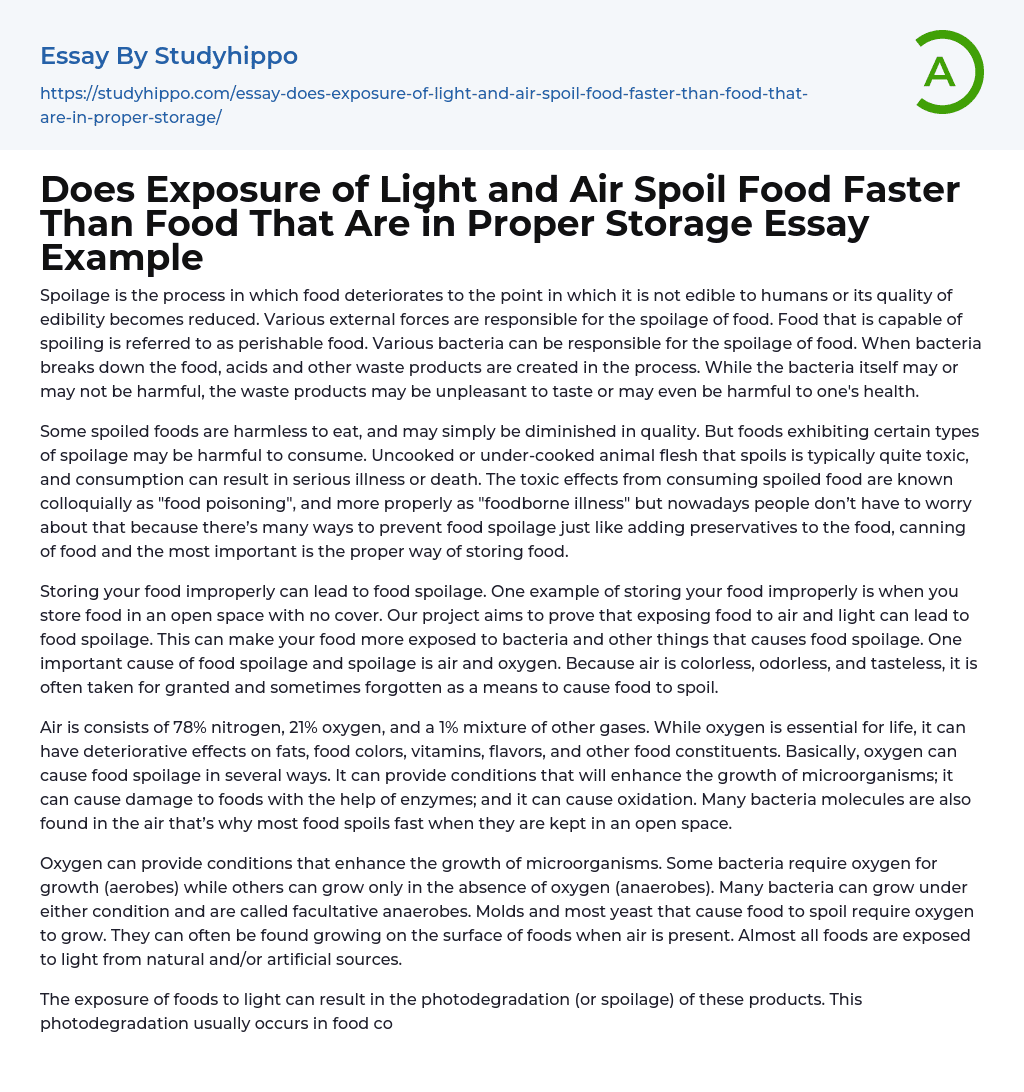

Does Exposure of Light and Air Spoil Food Faster Than Food That Are in Proper Storage Essay Example
Spoilage is the process in which food deteriorates to the point in which it is not edible to humans or its quality of edibility becomes reduced. Various external forces are responsible for the spoilage of food. Food that is capable of spoiling is referred to as perishable food. Various bacteria can be responsible for the spoilage of food. When bacteria breaks down the food, acids and other waste products are created in the process. While the bacteria itself may or may not be harmful, the waste products may be unpleasant to taste or may even be harmful to one's health.
Some spoiled foods are harmless to eat, and may simply be diminished in quality. But foods exhibiting certain types of spoilage may be harmful to consume. Uncooked or under-cooked animal flesh that spoils i
...s typically quite toxic, and consumption can result in serious illness or death. The toxic effects from consuming spoiled food are known colloquially as "food poisoning", and more properly as "foodborne illness" but nowadays people don’t have to worry about that because there’s many ways to prevent food spoilage just like adding preservatives to the food, canning of food and the most important is the proper way of storing food.
Storing your food improperly can lead to food spoilage. One example of storing your food improperly is when you store food in an open space with no cover. Our project aims to prove that exposing food to air and light can lead to food spoilage. This can make your food more exposed to bacteria and other things that causes food spoilage. One important cause of food spoilage an
spoilage is air and oxygen. Because air is colorless, odorless, and tasteless, it is often taken for granted and sometimes forgotten as a means to cause food to spoil.
Air is consists of 78% nitrogen, 21% oxygen, and a 1% mixture of other gases. While oxygen is essential for life, it can have deteriorative effects on fats, food colors, vitamins, flavors, and other food constituents. Basically, oxygen can cause food spoilage in several ways. It can provide conditions that will enhance the growth of microorganisms; it can cause damage to foods with the help of enzymes; and it can cause oxidation. Many bacteria molecules are also found in the air that’s why most food spoils fast when they are kept in an open space.
Oxygen can provide conditions that enhance the growth of microorganisms. Some bacteria require oxygen for growth (aerobes) while others can grow only in the absence of oxygen (anaerobes). Many bacteria can grow under either condition and are called facultative anaerobes. Molds and most yeast that cause food to spoil require oxygen to grow. They can often be found growing on the surface of foods when air is present. Almost all foods are exposed to light from natural and/or artificial sources.
The exposure of foods to light can result in the photodegradation (or spoilage) of these products. This photodegradation usually occurs in food constituents, such as pigments, fats, proteins, and vitamins and results in discoloration, off-flavor development, and vitamin losses. The light that is absorbed by the food can cause deteriorative reactions of the food constituents. In most solid foods, the light only penetrates the outer layer of the
product and photodegradation occurs in this surface layer.
Discoloration on the surface of foods can certainly affect consumer acceptance of these products. In liquid foods, light penetration can be greater and with mixing of the products due to agitation, larger portions of food constituents may be deteriorated. The light sensitivity of a food depends on many factors including the: light source strength and type of light that it emits; distance of the light source form the food; length of exposure optical properties of the packaging materials; oxygen concentration of the food; and the temperature.
The goal of food safety is to prevent the hazards that cause foodborne illness or injury. Most of the hazards in food are things you cannot see, smell, or taste. We live in a world with lots of microorganisms. Some microorganisms are good for us, but others can make us sick. Be careful in storing your food properly so that it won’t be contaminated with microorganisms that can harm us. Because people cannot usually see, smell, or taste microorganisms in food, it is important to practice food safety even when the food looks fine.
- Organic Chemistry essays
- Acid essays
- Calcium essays
- Chemical Bond essays
- Chemical Reaction essays
- Chromatography essays
- Ethanol essays
- Hydrogen essays
- Periodic Table essays
- Titration essays
- Chemical reactions essays
- Osmosis essays
- Carbohydrate essays
- Carbon essays
- Ph essays
- Diffusion essays
- Copper essays
- Salt essays
- Concentration essays
- Sodium essays
- Distillation essays
- Amylase essays
- Magnesium essays
- Acid Rain essays
- Food Safety essays
- Food Security essays
- Beverages essays
- Cuisines essays
- Dairy essays
- Desserts essays
- Fast Food essays
- Bread essays
- Meal essays
- Meat essays
- Organic Food essays
- Rice essays
- Sugar essays
- Taste essays
- Beef essays
- Coconut essays
- Crowd essays
- Dinner essays
- Juice essays
- Sainsbury essays
- Cooking essays
- Ginger essays
- Oreo essays
- Drink essays
- Beer essays
- Wine essays



